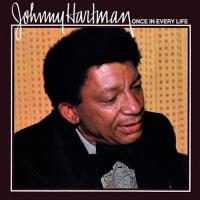Johnny Hartman's "Once In Every Life" Gets Well-Deserved 200g Treatment
Both for the music and spectacular sonics, for years Once In Every Life made both the audiophile and jazz enthusiast rounds. Clint Eastwood was a fan and so in 1995 he licensed songs from the album and put them in the movie "The Bridges of Madison County" that he directed and in which he starred. The soundtrack brought the soothing baritone vocalist a new, appreciative audience.
Quick aside: back then I received from Warner Brothers and Eastwood's Malpaso Productions a pre-release CD of the soundtrack, noting the inclusion of a few songs from this album. I was curious to hear how much degradation the digitizing process had produced but I wasn't prepared for what I heard: the Hartman tracks were at the wrong speed. Way too slow!
I contacted Malpaso Productions and managed to reach someone involved in the film's production and I told him what I heard. He dismissed me with sarcastic laughter and told me that it was impossible. I told him it was definitely possible because it was so. Then I told him "fine, but I guarantee you when Clint Eastwood hears it, he'll hear what I hear and he will be extremely pissed off since he bothered to license the tracks in the first place, but fine, have it your way..." (or words to that effect).
Some time later I got an apologetic phone call from the same individual profusely thanking me for catching the error: apparently there was a sampling rate discrepancy between the Hartman files and the rest of the track that they corrected for the commercial CD release .
Bee Hive's Susan and Jim Neumann, the album's producers, had hired first rate musicians for the session: Frank Wess on tenor sax and flute, Joe Wilder on trumpet and flugelhorn, Al Gafa on guitar, Billy Taylor on piano, Victor Gaskin bass and Keith Copeland drums. Wess of course spent years with Count Basie and the others have equally impressive resumés.
No doubt this was a pasted together session less organic than when a group that for years has toured and backed a singer, but the results surpass that of a typical "in and out" session, made more poignant in retrospect because it was Hartman's final recorded performance.
Side' two's "For All We Know", one of the tracks Eastwood used in "The Bridges of Madison County" alone is worth the price of the album but fortunately the rest of it is equally strong as Hartman was still in fine voice.
The studio-style recording is sensational. By "studio style" I mean it sounds as if the instruments are physically isolated and track-assigned and Gaskin's stand up bass sounds as if it's got a pick-up attached plugged directly in the board. You lose a bit of spatial context but the bottom end is otherwise spectacular.
When Wilder enters on the opener "Easy Living", you'll realize just how solid and three-dimensional are the images. That goes for Hartman's voice as well, which is pleasingly close-miked and pretty much left alone and not bathed in too much reverb.
This is a record fans of it have long hoped would be reissued but I'd been told that Eastwood had gone beyond licensing the tracks and had bought the tapes. Leave it to Chad Kassem to get the tapes, I think from the Neumanns. In any case the sound here is even better—way better—than the already fine original.
If you are a fan of this kind of "Great American Songbook" style singing, you'll love this record. How great was Hartman? He's the only vocalist John Coltrane recorded with, but you probably knew that. An easy to recommend reissue!
(Side story): So in 1993 I was hired to narrate and help execute a CD test disc called "The Ultimate Test CD" (ESX ESD 7059). The voice overs were recorded at Master Sound Astoria, a recording facility sufficiently large to record Broadway original cast albums. It was a deluxe space that I'm sure still survives, though the co-owner Ben Rizzi passed away.
Upon our introduction I exclaimed my enthusiasm for the Johnny Hartman album he'd engineered twenty plus years before. It was a good start to the session.
Of course, I played the officious audiophile test record announcer—very solemn. Somehow it got to a writer at The David Letterman Show, who decided I was ripe for mocking because one night after my wife and i had returned from seeing Janis Ian at The Bottom Line, I turned on Letterman's Show and I hear my voice! Letterman goes "Where's that guy now Paul?"
One of the tracks was a depth test that I lifted from a Chesky test CD where the announcer stands directly in front of the microphone, announces his position and then steps back and again announces his position ("I am standing one foot from the microphone") etc.
So after Letterman asks, I say "I am standing fifteen feet from the microphone" or whatever and then Letterman goes back to his interview. Ten minutes later he again says "Paul where's that guy now?" and the audience cracks up. Apparently this shtick has been ongoing since the show's beginning.
So this goes on for a few more times until Letterman takes the CD, throws it into the backdrop and says "Now you're in the river pal!"
The next day I call Letterman's show and propose I do a walk-on that night covered in seaweed and continue the "I am standing in front of a microphone..." shtick. They liked it, and said they'd get back to me in a few, which they did, but the logistics were too difficult, so it didn't happen.
In any case, this is a wonderful small gem of a record that I never tire of listening to that's never before sounded this good and it sounded quite good before!




